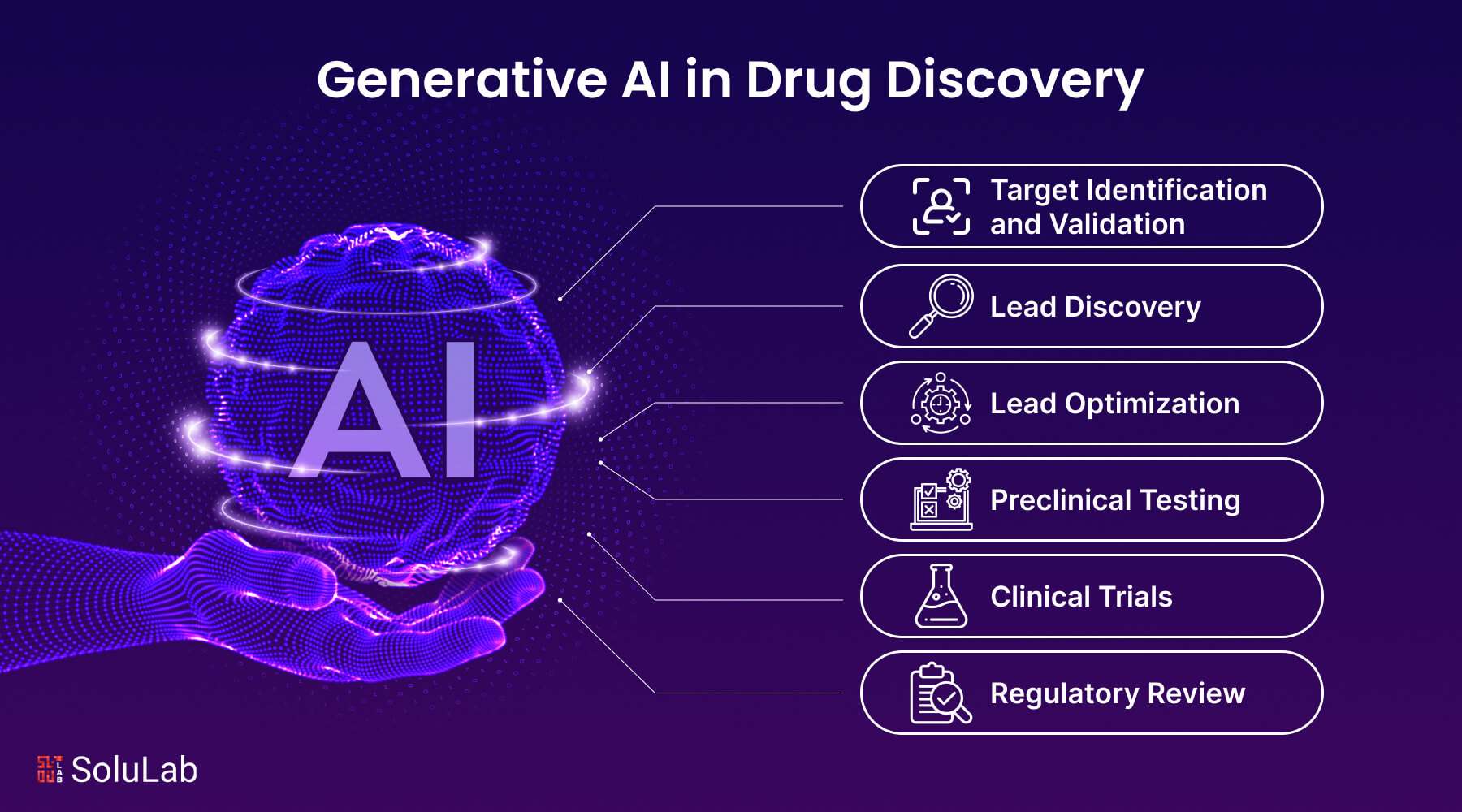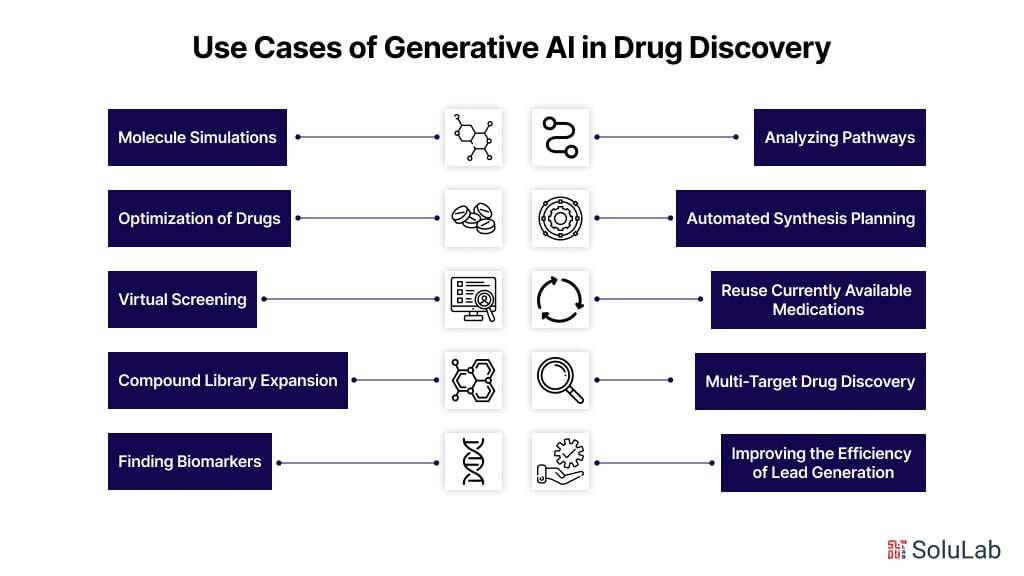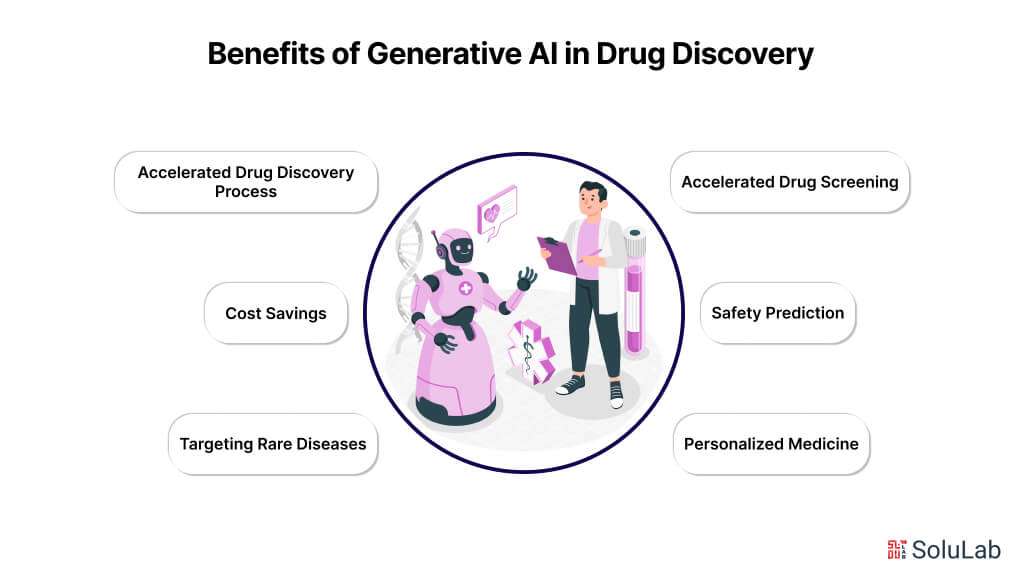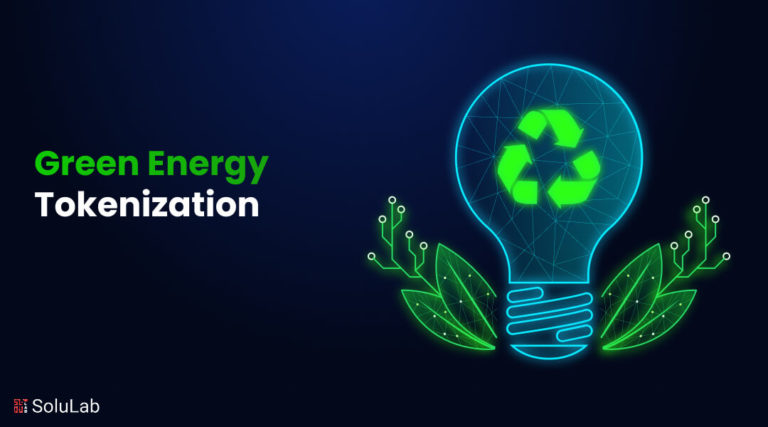
The drug development industry is being significantly impacted by generative AI, a modern field of artificial intelligence. Finding novel drugs has historically been a challenging and costly process that entails meticulously searching through chemical libraries to identify molecules that about practical for the prevention and treatment of illness.
Its growing importance is demonstrated by the anticipation. The increase in the global market was of generative AI for the discovery of drugs. Over 2.8 quadrillion tiny molecules, target combinations might be screened in a week because of NVIDIA’s partnership with Recursion Pharmaceuticals.
In this blog, we will explore how generative AI in drug discovery accelerates the development process, looking at its uses, effectiveness, and the exciting prospects it presents for creating innovative medications.
What Role Does Generative AI Play in Each Phase of the Drug Discovery Process?
From pre-market research to post-market monitoring, generative AI has a substantial impact on every stage of the drug discovery process, increasing efficacy and efficiency.
- Target Identification and Validation: To find and confirm putative molecular targets linked to illnesses, generative AI initially analyzes enormous volumes of biological and clinical data. It offers crucial insights for focusing on disease processes by forecasting the roles and interconnections of genes, proteins, and pathways.
- Lead Discovery: Artificial intelligence models such as GANs and RNNs are developed by producing new chemical structures throughout this process. By foretelling their binding affinities and pharmacological characteristics, they expedite the identification of lead compounds and simplify the process of choosing potential candidates.
- Lead Optimization: Artificial intelligence (AI) helps optimize lead compounds by suggesting chemical changes that improve therapeutic efficacy and safety. Through this procedure, medication candidates are improved pharmacologically and possible negative effects are minimized.
- Preclinical Testing: To evaluate toxicity, safety, and efficacy, generative AI analyzes enormous datasets. It lessens the need for intensive in vitro and in vivo testing by forecasting side effects and treatment outcomes.
- Clinical Trials: AI is essential to the planning and conduct of clinical studies. It improves trial methods and examines patient data to find potential trial candidates. During studies, real-time data analysis helps identify safety concerns and effectiveness patterns.
- Regulatory Review: AI streamlines the processing of complicated data for regulatory submissions, guaranteeing thorough and precise evaluation for medicinal approvals.
Working of Generative AI in Drug Discovery
Machine learning algorithms are used by GenAI for drug discovery to evaluate data and produce novel therapeutic prospects. Compared to the conventional method, this process can assist in finding possible medications more quickly and efficiently. Here is the breakdown of how it operates:
- Training of the Model: Large volumes of data such as chemical formulas, chemical reactions, and clinical trial outcomes, are used to train generative AI models.
- Examine the Information: To find trends and forecast how chemicals can react with biological targets, the model examines the data.
- Produce Novel Compounds: New molecules with certain characteristics, like binding to a particular receptor, are produced by the model.
- Assess the Molecules: To determine the best fit, the model will then compare the chemicals to the biological targets.
Use Cases of Generative AI in Drug Discovery

Drug discovery can be greatly impacted by generative AI as it can speed up and improve the process. Generative AI applications in drug discovery include the following:
1. Molecule Simulations
Novel chemical compounds and molecular structures can be produced via generative AI. Known as in silico testing, generative AI plays a key role in reducing the need for physical testing of potential therapeutic compounds by enabling high-precision chemical simulations to be carried out fully on computers. By accurately predicting and evaluating molecular interactions, behaviors, and binding affinities, this testing enhances the process of evaluating possible therapeutic options.
The high expenses connected with conventional laboratory-based chemical investigations are reduced by using this method. Through the precise prediction of molecular interactions and behaviors, generative artificial intelligence (AI) enables researchers to evaluate potential compounds quickly and thoroughly, eliminating the need for costly and time-consuming physical testing and speeding up the drug development process.
2. Optimization of Drugs
Generative AI drugs significantly contribute to enhancing existing drug compounds by suggesting precise modifications to drug molecules. This innovative AI technology aims to enhance the therapeutic effectiveness, safety profiles, and various pharmacological properties like solubility and binding affinity of medications.
By utilizing generative AI, drug development processes are streamlined, reducing the significant time and resources typically involved in drug optimization. Researchers can efficiently explore numerous modifications suggested by generative AI drugs to identify the most promising enhancements, thus accelerating the journey towards improved medications and potentially mitigating the risks associated with new drug development.
3. Virtual Screening
Generative AI in medicine significantly enhances virtual screening. It swiftly identifies possible drug candidates by modeling their interactions with target proteins using computer tools. By using machine learning models for forecasting a molecule’s bioactivity, generative AI improves the virtual screening process and allows researchers to carefully assess and filter a wide range of molecules for possible biological activity against the target without requiring physical experiments.
The efficiency of the drug development process is increased by this AI-enhanced method, which enables the quick identification and rejection of less promising candidates, saving a significant amount of time and money. Moreover, it increases the likelihood of discovering powerful and efficient compounds deserving of additional research and testing confirmation, guaranteeing a more targeted and strategic advancement in the drug discovery pathway.
4. Compound Library Expansion
By recommending analogs and derivatives of known compounds inside the library, generative AI helps significantly in the expansion of compound libraries in drug discovery. Through the use of machine learning algorithms and the analysis of structure-activity correlations (SAR) in current molecules, generative AI is able to forecast alterations that might improve desirable attributes like safety or efficacy.
These proposed modifications yield a variety of molecular configurations that expand the chemical library. To find possible drug candidates or improve lead compounds, researchers may then synthesize and test these newly created compounds, which will save time and money in the drug development process. This method’s iterative nature enables the chemical library to be improved and refined over time, ultimately assisting in the search for potent medicinal molecules.
5. Finding Biomarkers
Artificial intelligence (AI) algorithms are used in biomarker discovery to search through large datasets, such as proteomics and genomics data, for possible biomarkers linked to certain diseases or disorders. Particular molecular signs known as biomarkers can indicate the existence, course, or severity of an illness.
Finding these biomarkers is essential for accurate diagnosis, patient categorization, and medication development target selection. Generative AI is a useful tool for improving our understanding of illnesses and accelerating the development of customized therapies because of its capacity to handle complicated biological data effectively and identify subtle correlations.
6. Analyzing Pathways
For drug development and molecular biology pathway analysis, Generative AI is a useful tool. It helps scientists forecast how proteins will interact with one another and decipher intricate biological circuits.
Artificial Intelligence improves our knowledge of disease processes at the molecular level by modeling these interactions. With a better understanding of the pathways, researchers can find possible places of intervention where medications or other treatments can target and modify the pathways, leading to the eventual advancement of disease-specific therapy development. This method works especially well for finding new therapeutic targets and refining drug development plans.
7. Automated Synthesis Planning
By anticipating the most effective chemical reactions and paths to create a desired molecule, artificial intelligence (AI) can help design the synthesis of novel molecules. Artificial intelligence (AI) can forecast the most effective reaction paths for the synthesis of certain chemicals by using pattern recognition to optimize reactant ratios, temperature, and pressure.
Time and resources are saved as a result of the drug research and materials development processes being accelerated. AI-driven technologies may also suggest new chemical structures, which can help create unique substances with desired features. Artificial Intelligence (AI) in chemistry has the potential to accelerate the synthesis of novel compounds and streamline research.
8. Reuse Currently Available Medications
AI can extend the therapeutic efficacy of well-known chemicals, discover new uses for already-approved medications, and discover new uses for current ones. With the use of sophisticated algorithms and data analysis, AI is able to comb through enormous databases and reveal hidden connections between medications and illnesses. This methodology expedites the identification of plausible therapeutic interventions and extends the use of established substances beyond their initial intended purposes.
AI can effectively anticipate medication interactions, side effects, and efficacy by utilizing machine learning, which offers researchers and physicians insightful information. In the end, this creative use of AI may expedite medication development procedures and aid in the identification of more potent and varied therapy alternatives.
9. Multi-Target Drug Discovery
With its capacity to analyze enormous datasets, anticipate chemical interactions, and target various biological pathways linked to complicated illnesses like cancer, artificial intelligence (AI) is able to develop molecules. These AI-created drugs demonstrate a polypharmacological strategy by hitting many molecular sites at once, boosting their effectiveness, and maybe getting beyond resistance mechanisms.
This method enables a more thorough and individualized treatment plan by customizing the therapeutic intervention to each patient’s unique molecular details. AI’s adaptability in traversing the intricate world of biological interactions speeds up drug discovery and makes it easier to design novel, synergistic combinations that have the potential to completely change the way complex illnesses like cancer are treated.
10. Improving the Efficiency of Lead Generation
AI-driven drug development constantly uses iterative procedures to improve lead compounds after the first optimization. The technology uses machine learning development and sophisticated algorithms to examine large datasets in order to anticipate chemical interactions and find trends. By optimizing the chemical structures of lead compounds to improve target selectivity, this continuous refining increases the compounds’ effectiveness.
Additionally, by forecasting how chemicals will interact with biological systems, AI detects and minimizes any adverse effects. Drug candidates may be optimized more precisely and nuancedly using this dynamic method, which eventually enhances their safety profile and therapeutic potential over time.
Benefits of Generative AI in Drug Discovery

Generative AI systems in drug discovery offer compelling advantages for accelerating the process of identifying potential medications. By swiftly exploring a vast chemical space, these systems streamline the journey from initial discovery to clinical trials, significantly reducing the time required for drug development. Have a look at some of the great benefits of generative AI in drug discovery.
- Accelerated Drug Discovery Process: Generative AI systems in drug discovery expedite the exploration of a vast chemical space, drastically reducing the time needed to identify potential drug candidates. Researchers can swiftly analyze numerous compounds, expediting the entire drug development pipeline from initial discovery to clinical trials.
- Cost Savings: Generative AI significantly reduces the high costs associated with traditional drug discovery methods by minimizing reliance on expensive laboratory work and increasing the likelihood of identifying successful drug candidates. This leads to substantial cost savings throughout the research and development phases, making drug discovery more economically viable.
- Targeting Rare Diseases: Generative AI leverages existing datasets to propose therapeutic molecules for rare diseases with limited data, offering new avenues of hope for patients. By expanding the scope of drug discovery, this technology fosters innovation and exploration in treatment development for previously overlooked or understudied conditions.
- Personalized Medicine: Generative AI tailors treatments to individual patients based on their unique genetic makeup, optimizing treatment efficacy and minimizing adverse reactions. This personalized approach transforms healthcare by focusing on individual patient needs and improving overall patient outcomes.
- Accelerated Drug Screening: Generative AI swiftly analyzes extensive datasets of chemical compounds and their interactions with biological targets, expediting the early stages of drug discovery. This efficiency allows researchers to focus on the most promising compounds, ultimately speeding up the drug discovery process.
- Safety Prediction: Generative AI accurately forecasts potential side effects and toxicity early in the drug discovery process, prioritizing drug candidates with improved safety profiles. By identifying problematic compounds and optimizing molecules, this technology creates safer and more effective medications, reducing the risk of adverse events in clinical trials and post-market use.
Read Blog: Generative AI in Healthcare
Applications of Generative AI in Drug Discovery
By offering novel approaches to the creation, analysis, and optimization of therapeutic candidates, generative, AI is transforming the drug discovery process. Below are the applications of generative AI and drug discovery to understand the concept much better:
1. Optimization and Design
Generative AI is capable of creating completely original chemical molecules that are suited to particular biological purposes. It speeds up the drug design process by forecasting molecular characteristics and redefining molecules for safety efficiency and manufacturing feasibility.
2. Identification of Target
Finding appropriate biological targets is essential to a successful drug discovery process. By analyzing intricate biological data, generative, AI finds new targets and biomarkers, opening the door to the creation of treatments for diseases that were thought to be incurable.
3. Repurposing Drugs
By examining patterns and connections in biochemical and biological data, generative AI helps discover novel therapeutic application applications for already approved medication. This method drastically cut down on the time and expense of introducing therapists to the market.
4. Forecast of Toxicity
One of the main issues is drug development safety. Researchers can improve drugs before clinical testing by using generative AI to anticipate possible toxicity and adverse negative consequences early in the process.
Generative AI is transforming drug discovery by facilitating quicker data-driven decision-making and broadening the field of molecular research.
Factors Influencing Generative AI’s Increasing Importance in Drug Discovery
The use of generative AI for drug discovery is being driven by the following factors:
1. Growing Complexity of Drug Development: As our understanding of illnesses at the molecular level has improved, so too has the complexity of the drug discovery process. By sorting through enormous information, seeing subtle trends, and producing novel compounds or treatment possibilities catered to certain targets, generative AI may manage this complexity. This streamlines and quickens the process of finding new drugs.
2. Big Data and Molecular Information Availability: A rich supply of data for training and verifying Generative AI models is made possible by the accessibility of large datasets including details on chemical structures, biological tests, genomics, and other topics. AI systems can find more successful treatment candidates by using this data to generate more accurate and well-informed recommendations.
3. Support and Acknowledgment From Regulators: Regulators are becoming more aware of the possibilities presented by AI-driven technologies for drug development. The confidence to use these technologies is increased when regulatory agencies offer assistance and direction for integrating generative AI in the drug development process. This acknowledgment guarantees that the industry when using generative AI for drug research, may successfully handle regulatory hurdles.
4. Unmet Medical Needs: Generative AI has the ability to find medication candidates for illnesses for which there are no reliable therapies, thereby filling a gap in the medical field. Interest in and funding for generative AI are heavily influenced by its potential to dramatically affect patient outcomes. Patients with diseases that were thought to be difficult to cure before now have hope.
What are the Challenges in Drug Development Posed by Generative AI?
Even with their enormous promise, generative AI technologies still face several obstacles that must be overcome before they can be effectively included in drug discovery processes.
- Excellent Data Requirement: For training, generative models require vast, diversified, and high-quality datasets, however, experimental drug research data is frequently sparse, noisy, and prone to mistakes or outliners.
- Lack of Data for Uncommon Diseases: It can be difficult to find enough high-quality data for uncommon diseases or novel treatment targets.
- Training Data Biases: Unrealistic or distorted outcomes might be produced by models trained on small or biased outcomes.
- Ethical and Legal Issues: Patient protection, privacy of data, and ownership rights are all major issues brought up by these technologies.
Conclusion
Generative AI improves chemical design, target proof of identity, and drug optimization with speed, efficiency, and precision. It finds patterns and insights in massive data sets to address intricate and unmet medical requirements, including uncommon diseases, through data-driven decision-making. This technique boosts treatment, candidate, and success, and accelerates global health solution development.
We at SoluLab, a Generative AI Development Company, collaborate with forward-thinking businesses like Locus to spur creation and develop crucial solutions. Our team of skilled professionals can assist you if you want to use modern technologies like IoT, generative AI, and predictive analytics to improve business processes. Let’s work together to realize your idea and transform your sector. Get in touch with SoluLab right now to start creating more intelligent and effective business solutions!
FAQs
1. What role does Generative AI play in the search for new drugs?
Generative AI systems can analyze a patient’s genetic composition to predict how they will respond to a specific medication. To take these aspects into account while finding new drugs, they can also find biomarkers that indicate the stage and severity of the disease, and forecast a drug’s clinical trial success.
2. Which was the first medication that AI had found?
An overview of the multi-module generative AI pipeline that fueled the discovery, creation, and within-human testing of INSO18_055 was the first AI-generated medication to go through clinical testing.
3. Which data sets are frequently utilized in drug discovery to train AI models?
DTC, DGldb, DrugBank, ChEMBL, PubChem, and SIDER are of few examples of data sources. All of the sources and their big data can be used in the drug discovery process.
4. What impact does AI have on medication discovery cost-effectiveness?
By accelerating and improving the process, AI can lower the cost of drug research. Additionally, AI can predict drug interactions, find interesting compounds, and lessen the need for animal testing.
5. What are AI’s limitations in medicine development?
Even though AI has great potential for drug discovery, obtaining and using sizeable, reliable, and structured data sets continues to be a major challenge. The use of open-source databases is problematic, mostly because the data is frequently of low quality.





